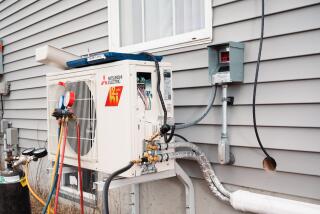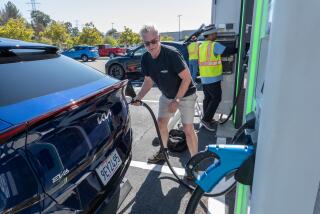Review: Zero DS: A plug-in electric commuter bike that is a rarity in the two-wheeled world
Battery electric automobiles have broken most of the barriers to ownership, even if they haven’t broken sales records.
Tesla overcame the performance and luxury hurdles with its sleek Model S. The Chevrolet Bolt EV smashed previous range limitations. In the two-wheeled electric world, Zero motorcycles may help shake commuter resistance among motorcyclists.
But just as electric cars haven’t achieved much market penetration — battery-powered plug-ins account for less than 1% of all new U.S. car sales — electric motorcycles are still a relative rarity in the two-wheeled world.
“Electric motorcycles are really good, and they work really well, but this is an extremely niche market,” said Cycle World Editor in Chief Mark Hoyer. “If you’re looking at an electric car, it’s easier to package it to carry the weight of the batteries, and get the range and give it luxury appointments. With a motorcycle, all of that is harder.”
Zero does not release sales numbers — except to say that sales grew 50% from 2015 to 2016 and are expected to grow more than that this year.
But the Scotts Valley, Calif., company controls most of the U.S. electric motorcycle market. Although there are several electric scooter companies fighting for market share, and Alta Motors and its Redshift MX are the recognized leader in electric motocross machines, most of the electric motorcycles on the street today are made by Zero.
I recently completed a monthlong loan of a 2017 Zero DS 6.5. The object of the experiment was to discover whether a lighter-weight, lower-cost, limited-mileage electric motorcycle would aid in my commute.
It wasn’t my first Zero experience. I reported on visiting the factory for one story and have tested several of its models, such as the lightweight FX.
Although I’ve been riding internal combustion two- and four-stroke motorcycles for decades, and truly love the sounds and smells they make as they carve the canyons and hurtle down the highways, I have also come to love the tremendous torque and sweet, smooth silence of the electric motorcycle.
But how would it behave as a daily driver? Where, how and how often would I charge it?
The DS, one of six models currently offered by Zero, is a dual sport bike. Its brushless, air-cooled Z-Force electric motor produces the equivalent of as much as 60 horsepower and 81 pound-feet of torque.
It features fully adjustable Showa suspension, front and rear, and Bosch ABS brakes. Strapped with Pirelli MT-60 dual purpose tires — on a 19-inch front wheel and 17-inch rear — it has a 33.2-inch seat height.
Quick off the throttle, the most powerful DS has been tested rushing from zero to 60 mph in less than 4 seconds. That machine retails for $13,995.
The DS 6.5, new for 2017, is the stripped-down city version. Its smaller battery makes 34 horsepower and 78 pound-feet of torque. While it’s not as quick as the big-battery version, it’s more affordable, with a suggested retail price of $10,995. (The company’s FX model, which features an even smaller battery, can be had for $8,495.)
It’s also lighter. The smaller DS 6.5 weighs 100 pounds less than the more powerful DS model.
The larger-battery DS has a claimed city range of 147 miles; the DS 6.5 has a city range of about half that.
The Charge Tank accessory, a $1,995 option that enables the Zero to plug into Chargepoint and other public stations, cuts charging time on the DS 6.5 to about 90 minutes for a full “tank” of juice — from about 4 1/2 hours without that accessory.
But even with the Charge Tank installed, that short city range had me a little concerned. Since my route to and from work involves some freeway riding, would I find myself charging up every time I commuted, or every other? Would I arrive at work, where there’s no place to plug in, without sufficient electricity to get home?
I needn’t have worried.
I left the office the first day with 100% battery capacity and 34 miles on the odometer. Riding mostly in Sport mode, because it was more fun that way, I put about 40 miles on the bike over the first four days.
On the fourth night, I plugged the Zero into a standard 120-volt wall plug in my garage. The next morning, it was restored to full charge. And that charge lasted me another five days of commuting.
Although I had the hardware for it, I never visited a Chargepoint station. I just plugged in overnight, once every five or six days, and rolled away full the next morning.
I haven’t seen the electric bill for that period yet, but Zero sets the average cost to recharge at 73 cents for a full tank of power. So, a month of doing a lot of my daily commute on this bike cost me less than $5.
Like all the Zero machines I’ve ridden, this DS felt well-built, balanced and solid. I found the standard suspension settings too firm for the pothole-ridden streets of Silver Lake, but was able to adjust them. I found the seat too hard, and the brakes too stiff. My short stints on the freeway had me wishing for a windscreen and brush guards — both of which are available as aftermarket extras.
Because it’s electric, and has a direct drive system, there’s no left-hand clutching or left-foot gear shifting required. You just screw on the throttle and go.
The simplicity of the ride always makes me feel a little more connected to the landscape. I seem to see more, and I certainly hear more, of what’s going on around me.
On a recent evening ride with 25 Zero owners, I experienced a sensation I’ve never had in 45 years of motorcycle riding.
We were winding up Nichols Canyon, in Hollywood, almost silent but for the whine of our tires, when I became aware of a strange sound. Alarmed that it might be something wrong with the bike, I slowed down to listen harder — and realized I was listening to crickets and frogs, chirping and croaking in the night.
“They have so much torque, and they’re fun to ride, and they’re so silent,” Hoyer said. “You get back on a gas motorcycle and you think what’s all this noise?”
On the DS, I found that I didn’t love the wide turning radius, but I really liked how easily its slender frame allowed me to lane-split on surface streets and the freeway.
And while I still love the silent, magic carpet acceleration of the electric motorcycles in general, I did have a couple of close calls that might not have happened had I been riding something that roared. Auto drivers tend not to see motorcycles. They’re even blinder when they can’t hear them.
One Zero owner I know had the dealer install a super-loud horn.
If I were a regular commuting person, always traveling to and from work in my own vehicle, I’d be a good candidate for this bike. Between the silence, the lane-splitting and the near-zero fuel costs, it would make a sensible choice for anyone who wants to get off four wheels and onto two.
One rider I met recently said the electric motorcycle he bought this year has dramatically altered his daily life.
Alec Henderson commutes from West Hollywood to his job at Kaiser Permanente in Pasadena. Wanting to go electric, but deciding he couldn’t afford a Tesla, he switched from public transportation to a Zero DS. That cut his travel time to and from work from about 90 minutes each way to around half an hour.
“It has completely changed my feelings about living in L.A.,” Henderson said. “Plus, it’s so much fun.”






